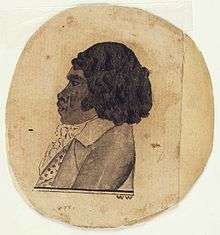Dharug language
| Darug | |
|---|---|
| Sydney | |
| Iyora | |
| Region | New South Wales |
| Ethnicity | Darug, Eora |
| Extinct | Late 19th / early 20th century |
| Dialects |
|
| Language codes | |
| ISO 639-3 |
xdk |
| Glottolog |
sydn1236[1] |
| AIATSIS[2] |
S64 |
The Sydney language, also referred to as Darug or Iyora (Eora), is an Australian Aboriginal language of the Yuin–Kuric group that is spoken in the region of Sydney, New South Wales. It is the traditional language of the Darug and Eora peoples.
The term Dharug, which can also be spelt "Darug", Dharukk, Dharoog, Dharrag, and Dararrug, etc., came from the word for yam: midyini. Dharug is the root, or the midyini, of the languages of the Sydney basin. The Darug population was greatly diminished since the onset of colonisation.[3]
Darug people recognise Sir William Dawes of the first fleet and flagship the Sirius as the first to record the original traditional tongue of the elder people of Sydney Darugule-wayaun.[4] Dawes was returned to England in December 1791, after disagreements with Governor Phillip on, among other things, the punitive expedition launched following the wounding of the Government gamekeeper,[5] allegedly by Pemulwuy.
During the 1990s and the new millennium some descendants of the Darug clans in Western Sydney have been making considerable efforts to revive Dharug as a spoken language. Today some modern Dharug speakers have given speeches in the Dharug language and younger members of the community visit schools and give demonstrations of spoken Dharug.[6]
Bowern (2011) lists Dharuk and Iyora as separate languages.
Name
The speakers did not use a specific name for their language prior to settlement by the First Fleet. The coastal dialect has been referred to as Iyora (also spelt Iora, Eora), which simply means "people", while the inland dialect has been referred to as Dharug (also spelt Darug, Dharuk, Dharruk), a term of unknown origin or meaning. Both names are also used to refer to all dialects of the language collectively.[7]
History

Their traditional territory spreads from the Georges River and Botany Bay in the south, to Port Jackson, north to Pittwater at the mouth of the Hawkesbury River, and west along the river to Parramatta.
The indigenous people identify themselves as Eora, literally meaning "the people", a word derived from Ee (yes) and ora (here, or this place). The language of the people is also called Eora.
With a traditional heritage spanning thousands of years, approximately 70 per cent of the Eora people died out during the nineteenth century as a result of smallpox, other pathogens and viruses, and the destruction of their natural food sources.
Phonology
Consonants
| Peripheral | Laminal | Apical | ||||
|---|---|---|---|---|---|---|
| Bilabial | Velar | Palatal | Dental | Alveolar | Retroflex | |
| Stop | b | k | c | t̪ | t | |
| Nasal | m | ŋ | ɲ | n̪ | n | |
| Lateral | ʎ | l | ||||
| Rhotic | ɲ | ɻ | ||||
| Semivowel | w | j | ||||
Vowels
| Front | Back | |
|---|---|---|
| High | i | u |
| Low | a | |
The language may have had a distinction of vowel length, but this is difficult to determine from the extant data.[8]
Words surviving in English
Examples of Dharuk words that have survived in English are:
- Names of animals: dingo, koala, wallaby and wombat
- Trees and plants: burrawang, kurrajong, geebung and waratah
- The tools boomerang, a word from the Turuwal sub-group, and woomera (spear-thrower)[9]
- Place names including Mulgoa, Toongabbie, Dural, Dharruk, Geebung and Winmalee
Revival

Although Dharug is classified as extinct, there is a small amount of descendants of the darug nations who still speak it and efforts have been made to revive the language. The darug language has acquired current living speakers through the efforts of Chifley College's Dunheved campus in Sydney.[10]
Notes
- ↑ Hammarström, Harald; Forkel, Robert; Haspelmath, Martin; Bank, Sebastian, eds. (2016). "Sydney". Glottolog 2.7. Jena: Max Planck Institute for the Science of Human History.
- ↑ Darug at the Australian Indigenous Languages Database, Australian Institute of Aboriginal and Torres Strait Islander Studies
- ↑ Troy (1994): p. 5.
- ↑ "The notebooks of William Dawes". School of Oriental and African Studies and NSW Department of Aboriginal Affairs. Retrieved 21 September 2010.
- ↑ "Dawes, William (1762 - 1836)". Australian Dictionary of Biography Online. Retrieved 16 September 2010.
- ↑ "Dharug Dalang". CITIES. Retrieved 21 September 2010.
- ↑ Troy (1994): p. 9.
- ↑ Troy (1994): p. 24.
- ↑ boomerang.org.au; see under "The Origin of Boomerang". Retrieved 16 January 2008.
- ↑ . Lost Aboriginal language revived. BBC News. Retrieved on 14 April 2009.
References
- Troy, Jakelin (1994). The Sydney Language. Canberra: Panther. ISBN 0-646-11015-2.
- Broome, Richard (2001). Aboriginal Australians. Sydney: Allen & Unwin. ISBN 1-86508-755-6.
External links
- The Aboriginal language of Sydney (with audio sample)
- Jeremy Steele's partial reconstruction of the Sydney language
- Bibliography of Dharug people and language resources, at the Australian Institute of Aboriginal and Torres Strait Islander Studies
- Bibliography of Eora people and language resources, at the Australian Institute of Aboriginal and Torres Strait Islander Studies